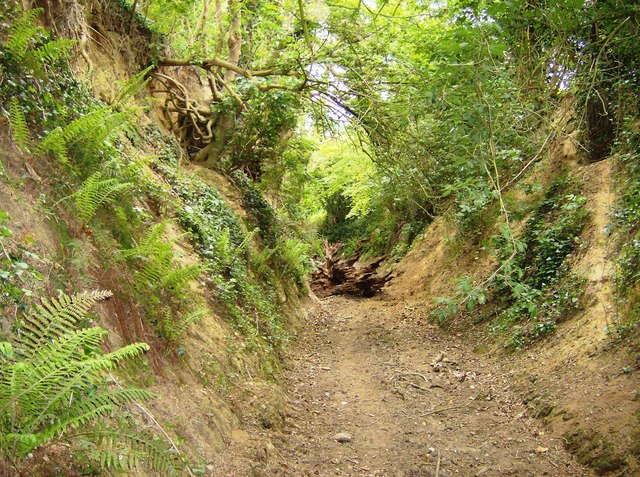Holloway

|
| This path becomes a holloway before emerging onto a minor road. Here it is nearly blocked by a fallen tree, which has been cleared except the massive root ball. |
Contents |
[edit] Introduction
A holloway (also known as a hollow way or sunken lane) is a path that has been carved into a wooded area over time, typically due to traffic from humans, animal hooves or cart wheels. The term holloway is thought to originate from the Old English phrase hola weg, which means sunken road.
These thoroughfares are generally formed in the natural landscape without the use of equipment. Their development is sometimes aided by erosion caused by the movement of water (brought about by excessive rainfall and subsequent flooding), which deepens the tunnelling effect.
[edit] History
The oldest holloways date back to the early Iron Age. According to holloway expert Robert Macfarlane, it is thought that none originated after the 1700s. However, it is difficult to date their origins precisely. Prior to the development of more modern roadways, holloways provided an essential network of trenches for rural transport and communication.
[edit] Creation
This human-made infrastructure is usually significantly below the adjacent landscape - sometimes by more than three metres. As a result, it is not unusual for trees or hedges to grow above the holloway with their limbs and leaves curving over the top. This can form a protective canopy that creates the effect of a tunnel, with the deep roots of the trees visible in the banks on either side.
Holloways occur most commonly in areas where the ground is soft. The soil typically includes significant wind-blown dust, and sandstone or chalk are present in the natural geology. Because the composition of the ground is made up of softer materials, it is easier for paths to form.
In southern England, holloways are a common part of the landscape, particularly in places such as the North and South Downs and the Surrey Hills. They are also found in the western part of the UK, such as the less developed regions of Dorset and west Wales.
[edit] Purposes
Other than their original purpose as a pedestrian and livestock passageway, holloways served additional purposes, including:
- Natural boundaries between estates.
- Strategic landmarks during military campaigns.
- Safe habitats and migratory routes for wildlife.
- Ecological and geological preservation zones.
Some holloways have been made into modern roads for motorised traffic. These are usually single track lanes that require passing places. Others have been preserved as green lanes and are used as bridleways, while some remain inactive.
[edit] Related articles on Designing Buildings Wiki
- Chalk aquifer.
- Clunch.
- Forests.
- Lane.
- National nature reserves.
- Pathway.
- Rural area.
- Sandstone.
- The conservation of historic transport infrastructure.
[edit] External resources
- Robert Macfarlane, Holloways.
Surrey Hills Directory
[edit] Planning
Building Design in the Surrey Hills
[edit] Highways
Conserving and Enhancing Country Lanes in the Surrey Hills AONB
[edit] Biodiversity & Landscape
Landscapes Review: National Parks & AONBs 2019
Light Pollution - Threat to Migrating Birds
Making Local Nature Recovery Strategies deliver
[edit] Health & Wellbeing
Nature and Wellbeing: The Evidence
How nature can be used to improve wellbeing






